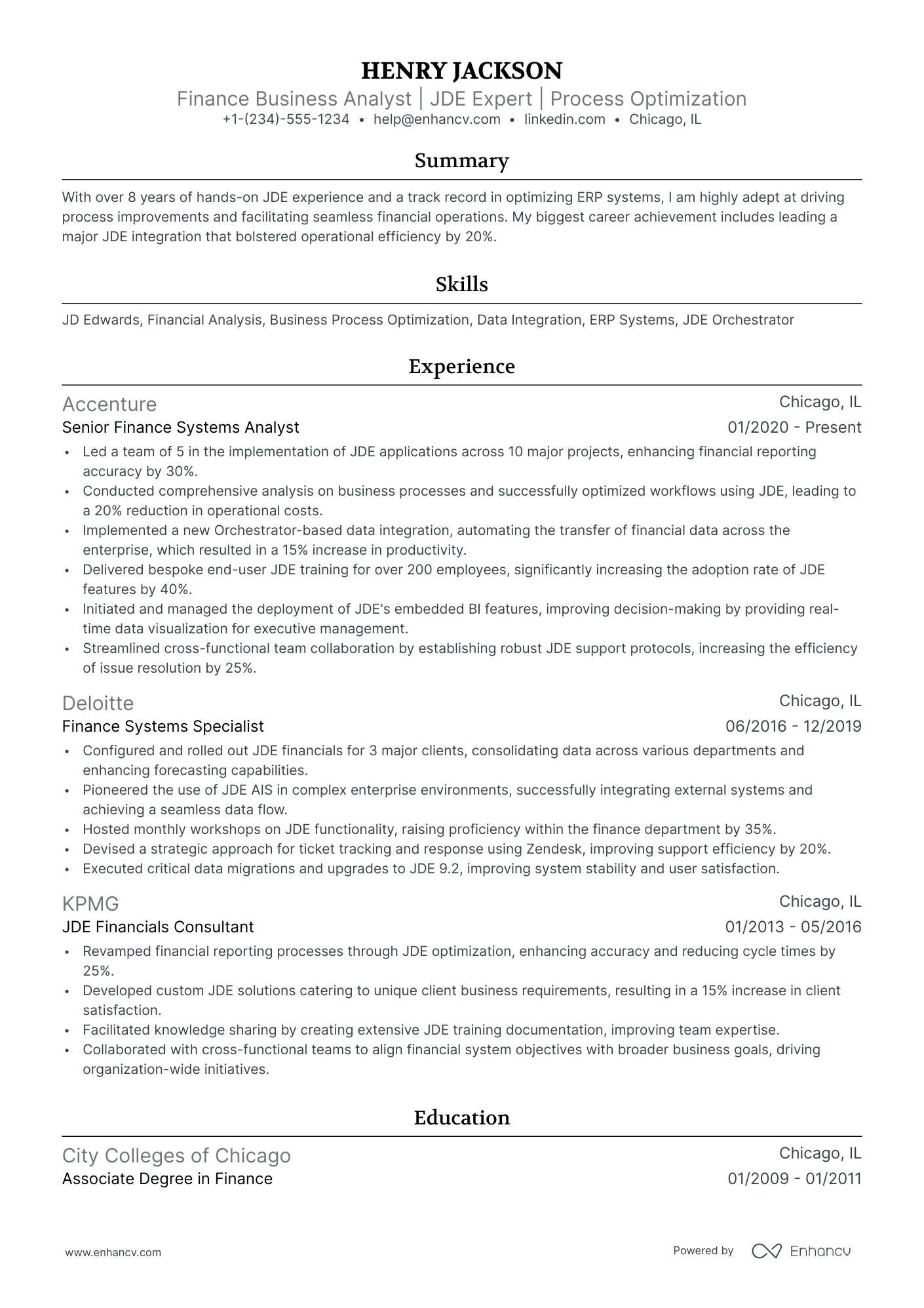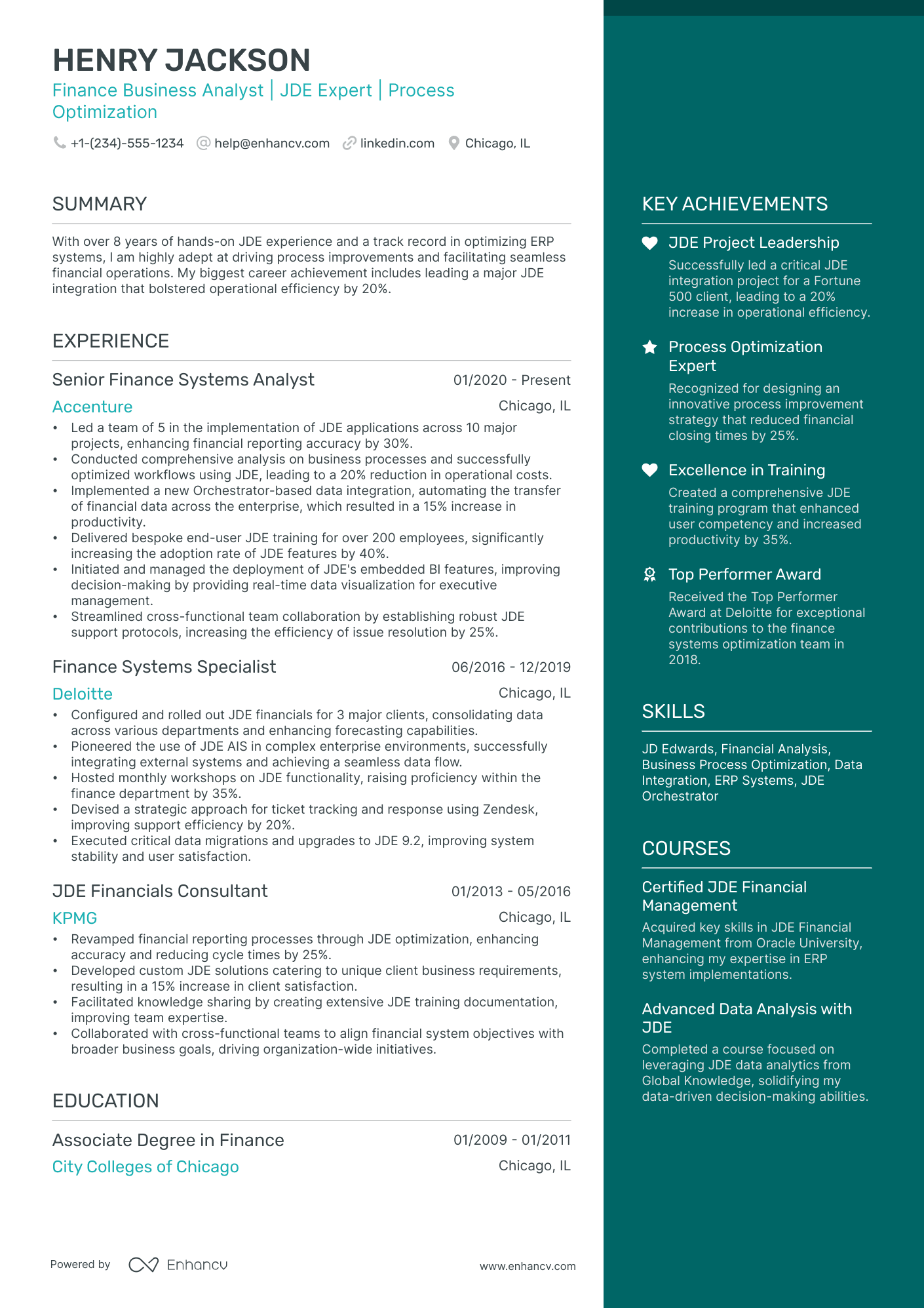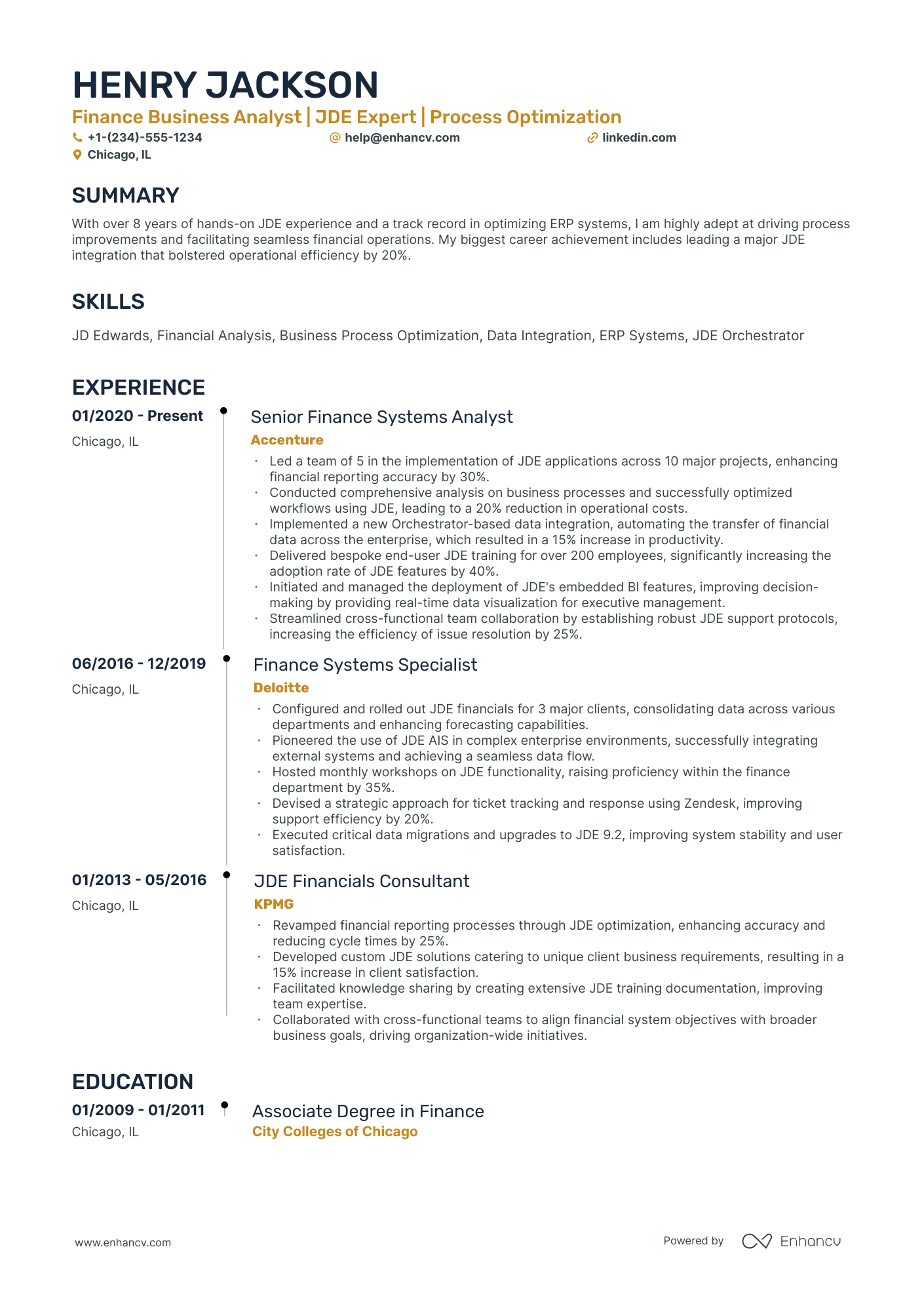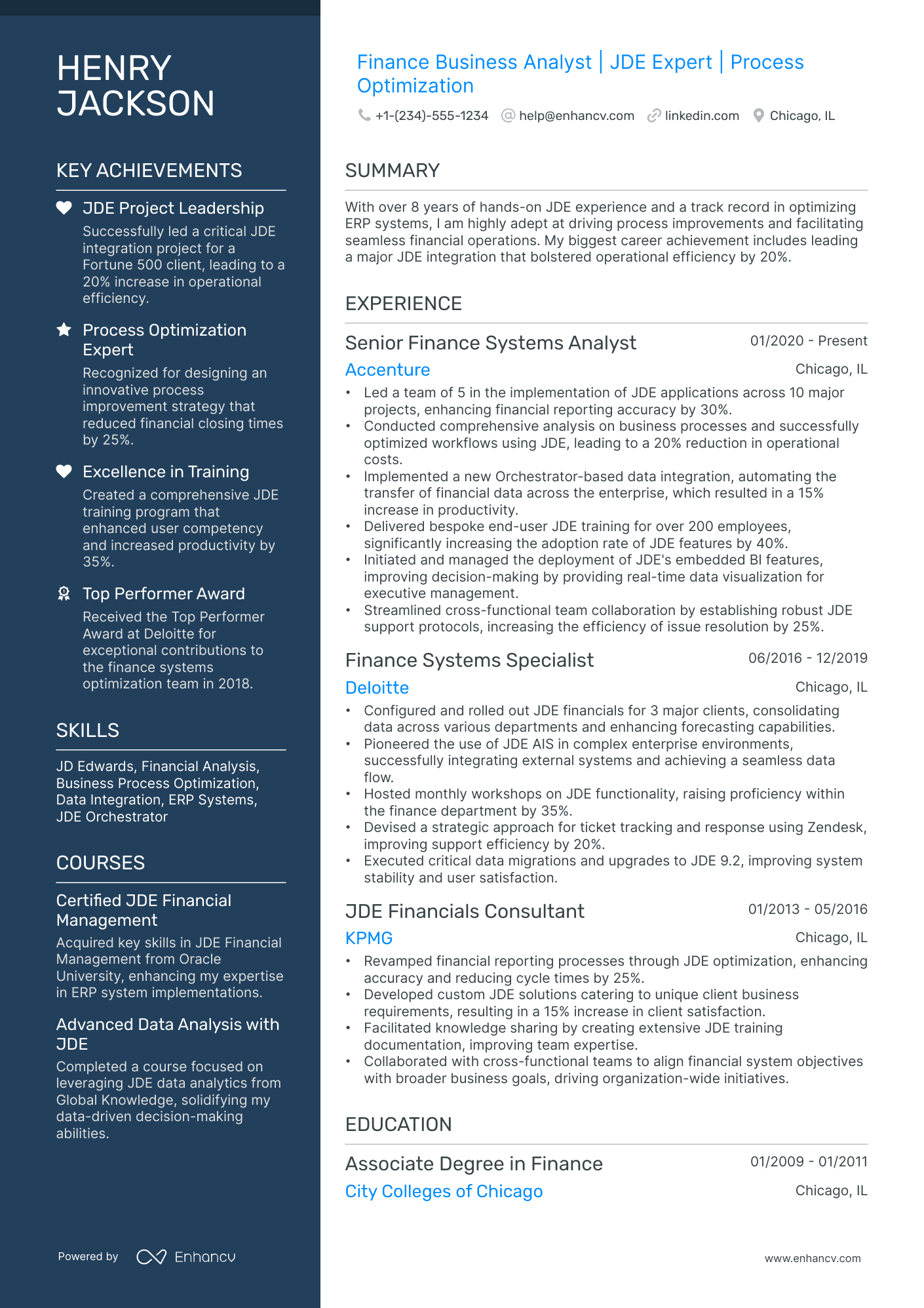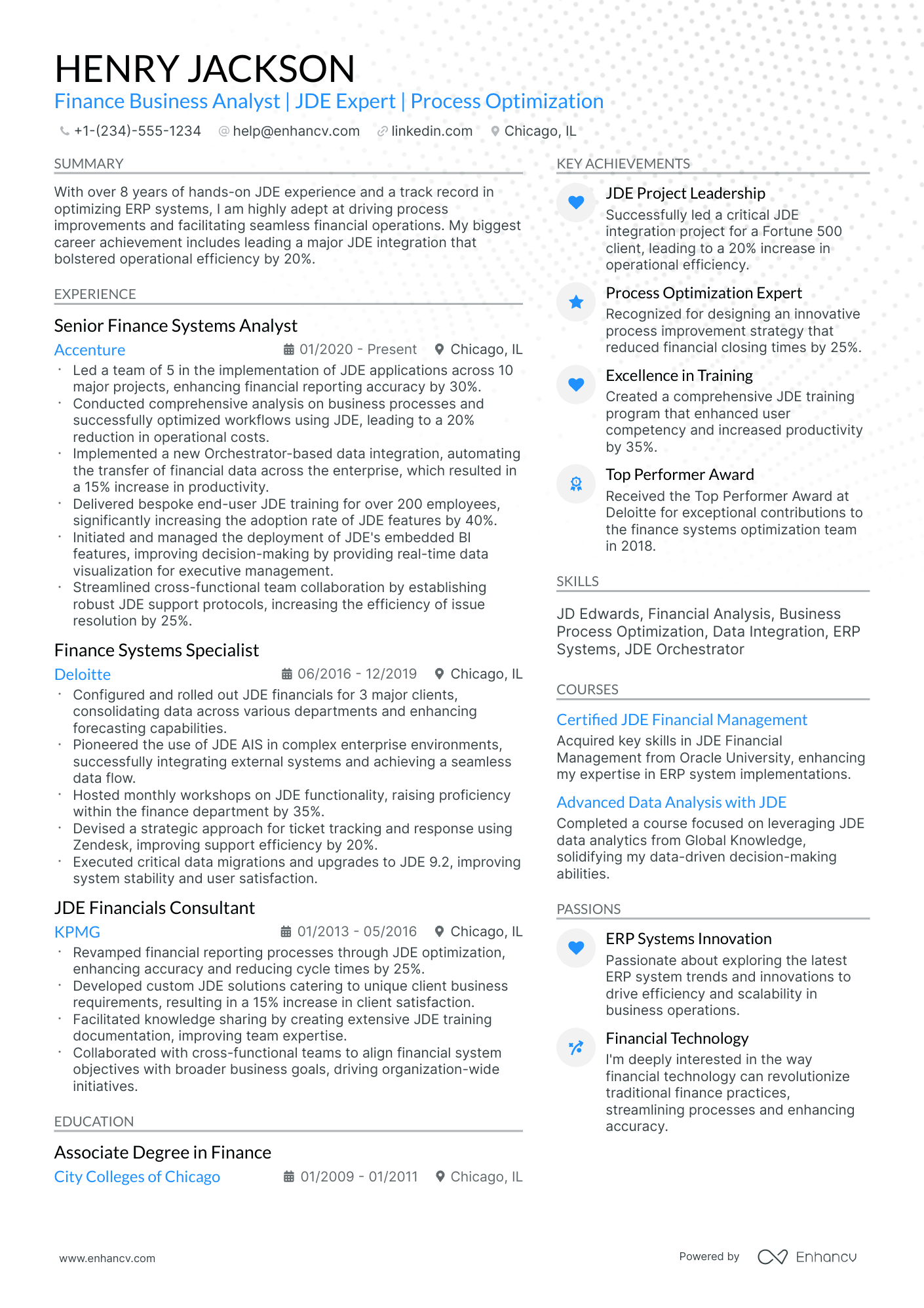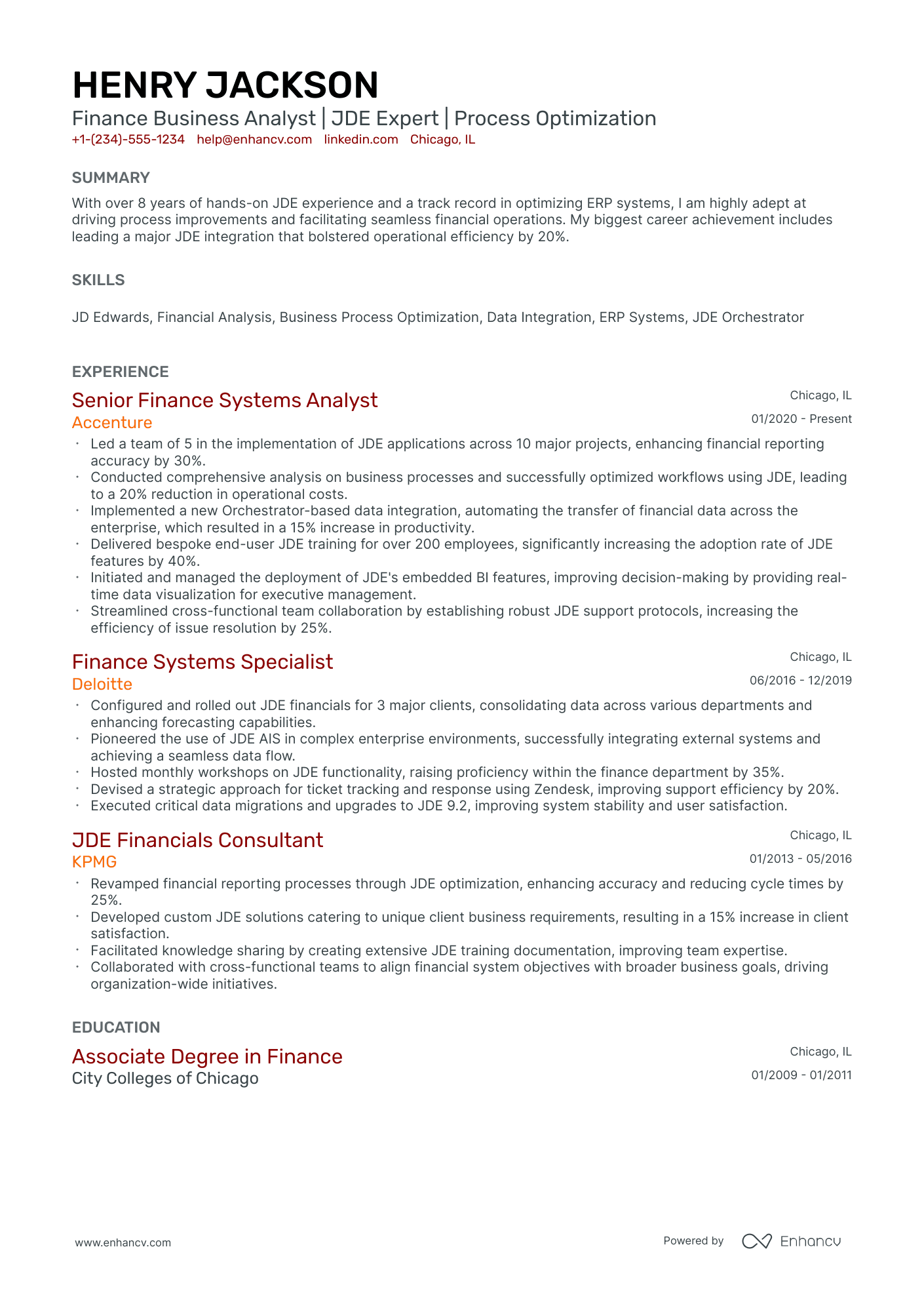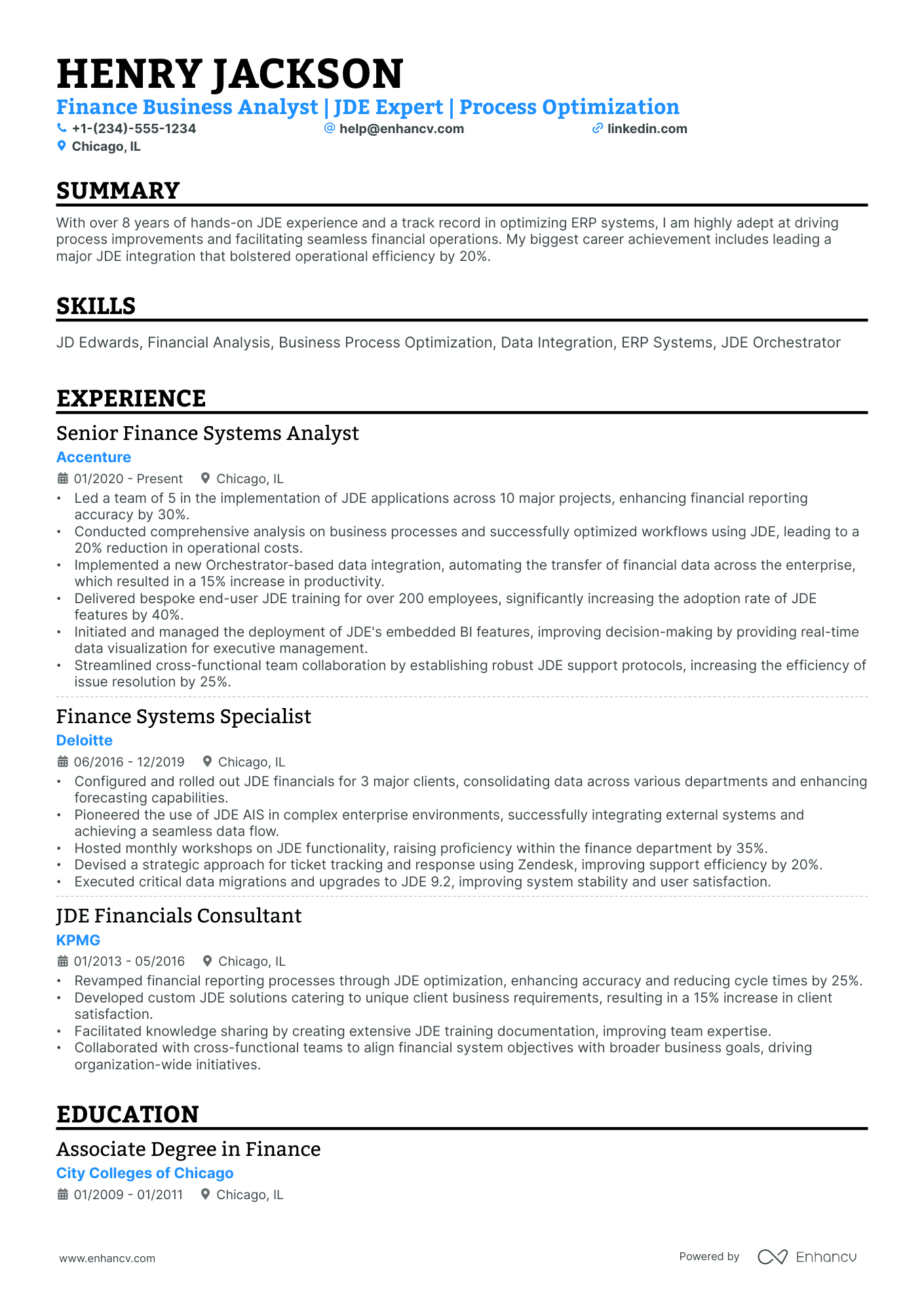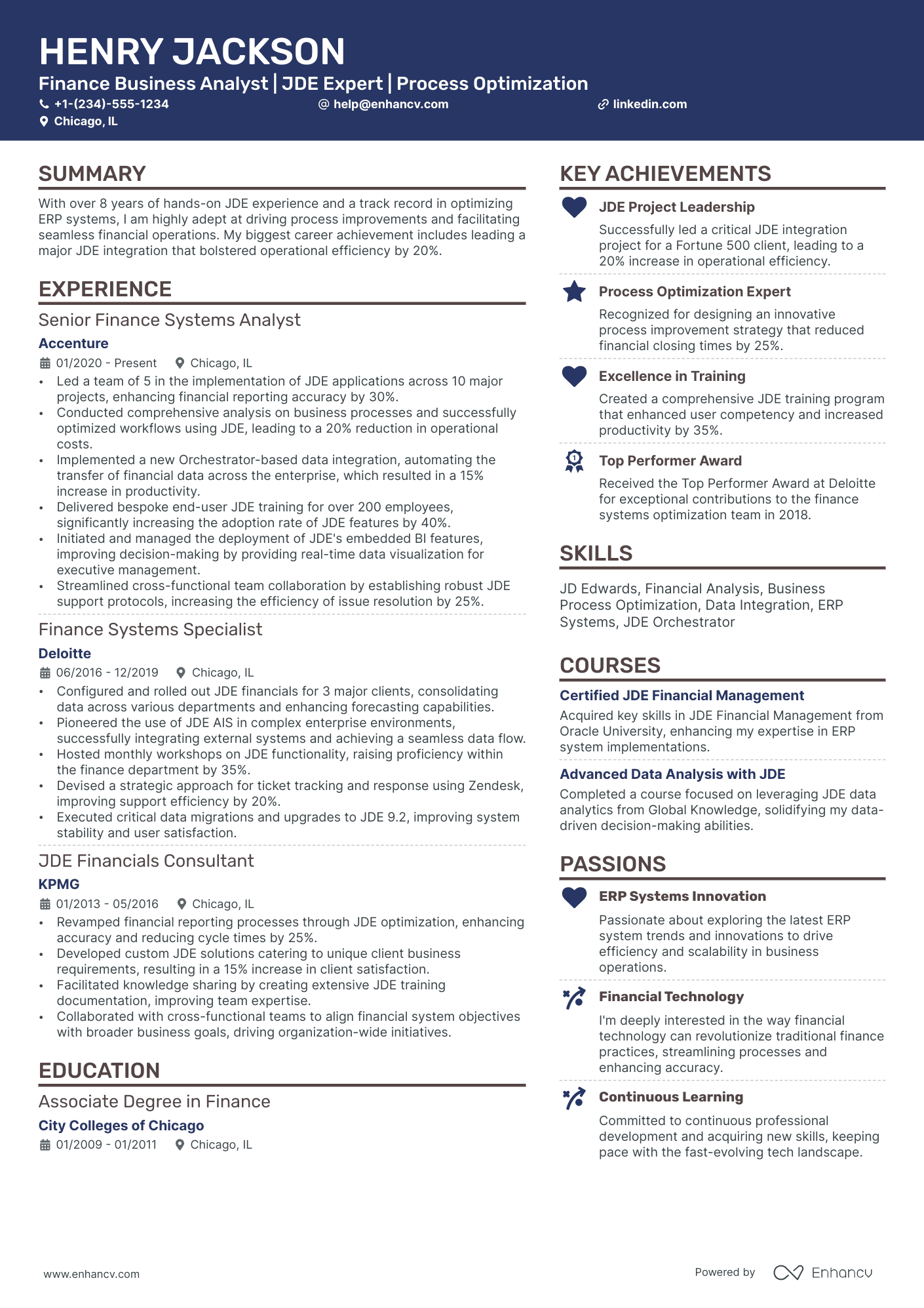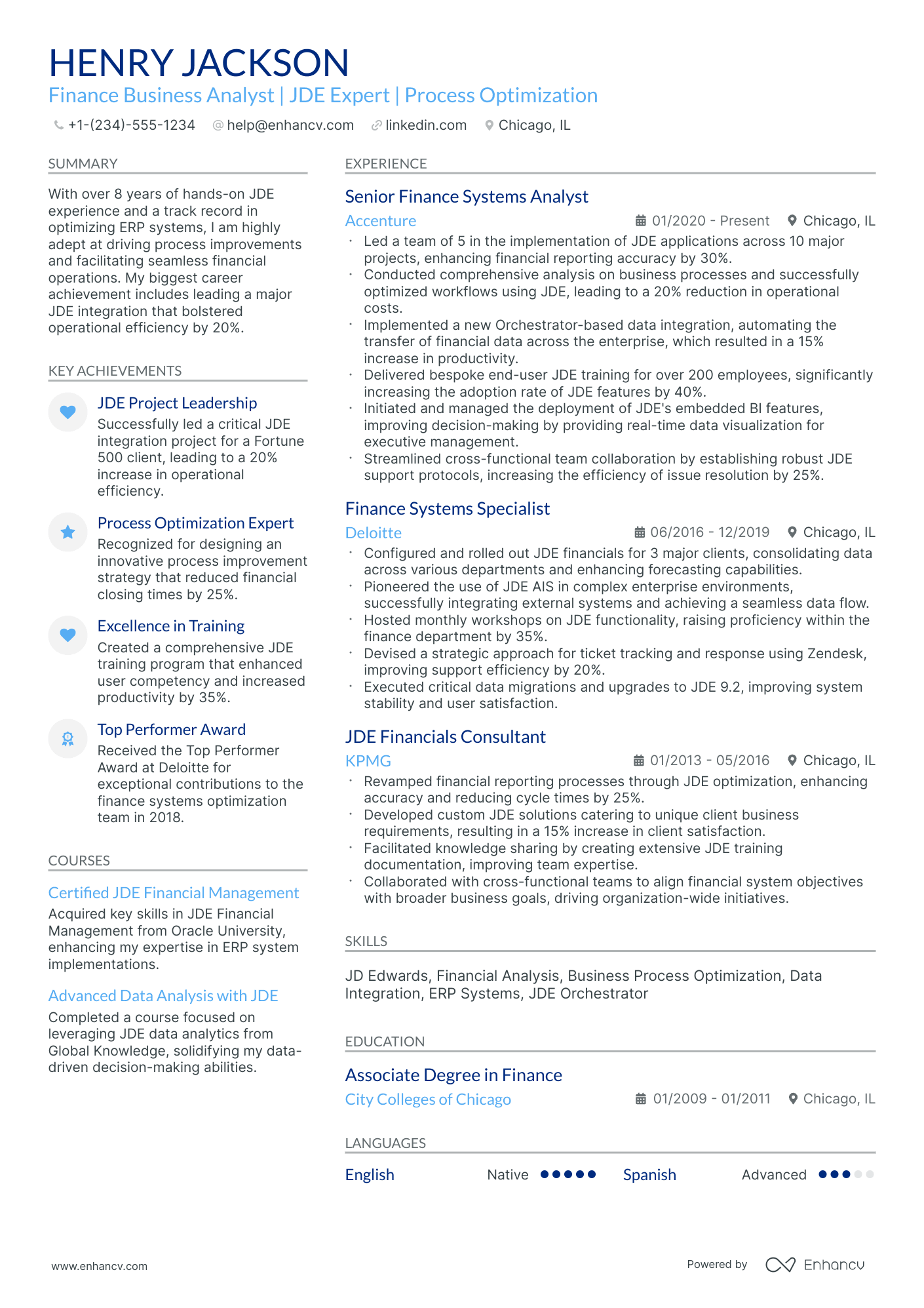As a finance business analyst, articulating your complex analytical experience into a concise and relatable resume can be a daunting task. Through our comprehensive guide, we'll provide you with strategies to effectively communicate your expertise, ensuring your resume resonates with potential employers.
- Sample industry-leading professional resumes for inspiration and finance business analyst resume-writing know-how.
- Focus recruiters' attention on what matters most - your unique experience, achievements, and skills.
- Write various resume sections to ensure you meet at least 95% of all job requirements.
- Balance your finance business analyst technical expertise with personality to stand out amongst candidates.
If the finance business analyst resume isn't the right one for you, take a look at other related guides we have:
- Risk Manager Resume Example
- General Ledger Accounting Resume Example
- Certified Financial Planner Resume Example
- External Auditor Resume Example
- Credit Manager Resume Example
- Purchasing Director Resume Example
- Financial Planning Analyst Resume Example
- Phone Banking Resume Example
- Audit Director Resume Example
- Accounts Clerk Resume Example
Professional finance business analyst resume format advice
Achieving the most suitable resume format can at times seem like a daunting task at hand.
Which elements are most important to recruiters?
In which format should you submit your resume?
How should you list your experience?
Unless specified otherwise, here's how to achieve a professional look and feel for your resume.
- Present your experience following the reverse-chronological resume format . It showcases your most recent jobs first and can help recruiters attain a quick glance at how your career has progressed.
- The header is the must-have element for your resume. Apart from your contact details, you could also include your portfolio and a headline, that reflects on your current role or a distinguishable achievement.
- Select relevant information to the role, that should encompass no more than two pages of your resume.
- Download your resume in PDF to ensure that its formatting stays intact.
Think about the location of your application – Canadian resumes, for instance, might follow a different structure.
Upload & Check Your Resume
Drop your resume here or choose a file. PDF & DOCX only. Max 2MB file size.
PRO TIP
Always remember that your finance business analyst certifications can be quantified across different resume sections, like your experience, summary, or objective. For example, you could include concise details within the expertise bullets of how the specific certificate has improved your on-the-job performance.
The five (plus) definite sections your resume for a finance business analyst job should include are:
- Header with your headline, contact details, and/or a preview of your work
- Summary (or objective) to pinpoint how your success aligns with the role
- Experience with bullets of your most relevant achievements in the field
- Skills to integrate vital job requirements (both technical and personal)
- Your further dedication to the field, showcased via relevant higher education and/or certifications
What recruiters want to see on your resume:
- Demonstrated proficiency in financial modeling and analytical tools (e.g., Excel, SQL, Python).
- Experience with financial reporting, budgeting, and forecasting, including knowledge of GAAP or IFRS.
- Familiarity with financial software systems (e.g., SAP, Oracle, QuickBooks) and business intelligence tools (e.g., Tableau, Power BI).
- Ability to identify cost-saving opportunities and risk management strategies through data analysis.
- Understanding of financial regulations and compliance requirements specific to the industry or sector the business operates within.
Advice for your finance business analyst resume experience section - setting your application apart from other candidates
Your resume experience section needs to balance your tangible workplace achievements with job requirements.
The easiest way to sustain this balance between meeting candidate expectations, while standing out, is to:
- Select really impressive career highlights to detail under each experience and support those with your skills;
- Assess the job advert to define both the basic requirements (which you could answer with more junior roles) and the more advanced requirements - which could play a more prominent role through your experience section;
- Create a separate experience section, if you decide on listing irrelevant experience items. Always curate those via the people or technical skills you've attained that match the current job you're applying for;
- Don't list experience items from a decade ago - as they may no longer be relevant to the industry. That is, unless you're applying for a more senior role: where experience would go to demonstrate your character and ambitions;
- Define how your role has helped make the team, department, or company better. Support this with your skill set and the initial challenge you were able to solve.
Take a look at how real-life finance business analyst professionals have presented their resume experience section - always aiming to demonstrate their success.
- Developed financial models to identify trends and business opportunities, increasing revenue by 15% over two years.
- Led the quarterly budget forecasting process and coordinated with cross-functional teams, reducing costs by 10% annually.
- Implemented a new reporting system using Power BI that enhanced data visualization and informed strategic decisions.
- Conducted in-depth variance analyses to understand budget discrepancies, which resulted in a 5% recapture of misallocated funds.
- Spearheaded the implementation of an ERP system, which standardized financial procedures across the company.
- Collaborated on cross-functional teams on the Merger & Acquisition project, contributing to a successful due diligence process.
- Managed a portfolio of projects with a budget exceeding $20M, delivering all projects within time and budget constraints.
- Introduced advanced statistical analysis to forecast market trends, which informed executive-level strategy.
- Supervised a team of junior analysts, mentoring them on advanced financial concepts and analytical techniques.
- Orchestrated a company-wide cost reduction initiative, identifying inefficiencies that led to a 20% decrease in operational expenses.
- Partnered with IT to develop automated financial reporting tools, enhancing accuracy and efficiency by 30%.
- Facilitated stakeholder meetings to align financial forecasts with long-term business objectives, significantly improving strategic planning.
- Authored comprehensive risk management policies, diminishing financial exposure by diversifying investment portfolios.
- Evaluated and improved the financial modeling processes, which increased forecast accuracy by 25%.
- Negotiated with external vendors to reduce costs for financial software licenses, saving the company $200K annually.
- Advised on a $50M capital raise initiative, crafting investment memoranda and investor presentations that attracted key stakeholders.
- Harmonized financial reporting requirements post-acquisition, ensuring seamless integration of financial systems from different entities.
- Conducted profitability analysis for new product lines, which informed the launch strategy and resulted in a 30% increase in market share.
- Implemented a business intelligence tool that tracked KPIs, leading to data-driven decisions and a 12% growth in annual profits.
- Performed competitive analysis to benchmark company performance, identifying key areas for improvement, and driving operational changes.
- Delivered comprehensive training programs for new financial software, ensuring 100% adoption within the finance department.
- Analyzed complex financial data to assist in strategic planning, leading to a successful market penetration resulting in a 22% increase in sales.
- Optimized cash flow management strategies, which maximized financial resources and supported new business initiatives.
- Led due diligence efforts for potential acquisitions, meticulously reviewing financial statements and market analyses to ensure profitable investments.
Quantifying impact on your resume
- Include quantified results of financial analysis to demonstrate the impact of your recommendations on revenue growth or cost reduction.
- Highlight specific models you've built, such as predictive forecasting models, and the value they've added through improved accuracy or efficiency.
- Mention any instances where you optimized investment portfolios and show the resulting increase in performance metrics.
- Detail the size of budgets you've managed or contributed to managing, emphasizing your capability in handling substantial financial resources.
- Showcase your experience with financial reporting by specifying the types of reports you've produced and their frequency.
- List any financial systems or tools you've implemented or improved, along with the quantifiable benefits observed such as time savings or error reductions.
- Refer to any cost-benefit analyses you have conducted and how they influenced business decisions or strategies.
- Enumerate any audits or financial compliance activities you've led and the implications they had on the business's fiscal integrity.
Action verbs for your finance business analyst resume
What to do if you don't have any experience
It's quite often that candidates without relevant work experience apply for a more entry-level role - and they end up getting hired.
Candidate resumes without experience have these four elements in common:
- Instead of listing their experience in reverse-chronological format (starting with the latest), they've selected a functional-skill-based format. In that way, finance business analyst resumes become more focused on strengths and skills
- Transferrable skills - or ones obtained thanks to work and life experience - have become the core of the resume
- Within the objective, you'd find career achievements, the reason behind the application, and the unique value the candidate brings about to the specific role
- Candidate skills are selected to cover basic requirements, but also show any niche expertise.
Recommended reads:
PRO TIP
Listing your relevant degrees or certificates on your finance business analyst resume is a win-win situation. Not only does it hint at your technical capabilities in the industry, but an array of soft skills, like perseverance, adaptability, and motivation.
Finance business analyst resume skills section: writing about your hard skills and soft skills
Recruiters always care about the skill set you'd bring about to the finance business analyst role. That's why it's a good idea to curate yours wisely, integrating both hard (or technical) and soft skills. Hard skills are the technology and software you're apt at using - these show your suitability for the technical aspect of the role. They are easy to track via your experience, certifications, and various resume sections. Your soft skills are those personality traits you've gained over time that show how you'd perform in the specific team, etc. Soft skills are more difficult to qualify but are definitely worth it - as they make you stand out and show your adaptability to new environments. How do you build the skills section of your resume? Best practices point that you could:
- Include up to five or six skills in the section as keywords to align with the advert.
- Create a specific technical skills section to highlight your hard skills aptitude.
- Align the culture of the company you're applying to with your soft skills to determine which ones should be more prominent in your skills section.
- Make sure you answer majority of the job requirements that are in the advert within your skills section.
A finance business analyst's resume requires a specific skill set that balances both industry-specific hard skills with personal, soft skills. Discover the perfect mix for the finance business analyst role from our list:
Top skills for your finance business analyst resume:
Financial Modeling
SQL
Excel
Tableau
Python
Power BI
SAP
Oracle Financial Services
R
QuickBooks
Analytical Thinking
Communication
Problem Solving
Attention to Detail
Team Collaboration
Time Management
Adaptability
Critical Thinking
Stakeholder Management
Presentation Skills
PRO TIP
Listing your relevant degrees or certificates on your finance business analyst resume is a win-win situation. Not only does it hint at your technical capabilities in the industry, but an array of soft skills, like perseverance, adaptability, and motivation.
Your academic background: should you include your education and certifications on your finance business analyst resume?
Adding relevant education and certifications to your finance business analyst resume is beneficial, whether you're an experienced candidate or just starting in the field.
Featuring your higher education degree that aligns with the role demonstrates your commitment to the industry. On your finance business analyst resume, include the start and graduation dates, followed by the name of the institution that awarded your degree.
Regarding certifications, it's wise to list those most relevant to the role or that have contributed to your array of crucial technical or personal traits. Be sure to include the name of the certificate and the awarding institution.
If uncertain about which certifications to feature prominently on your finance business analyst resume, refer to our compiled list of the most in-demand ones for guidance.
The top 5 certifications for your finance business analyst resume:
- Chartered Financial Analyst (CFA) - CFA Institute
- Certified Business Analysis Professional (CBAP) - International Institute of Business Analysis (IIBA)
- Financial Risk Manager (FRM) - Global Association of Risk Professionals (GARP)
- Chartered Alternative Investment Analyst (CAIA) - CAIA Association
- Certified Public Accountant (CPA) - American Institute of Certified Public Accountants (AICPA)
PRO TIP
Always remember that your finance business analyst certifications can be quantified across different resume sections, like your experience, summary, or objective. For example, you could include concise details within the expertise bullets of how the specific certificate has improved your on-the-job performance.
Recommended reads:
The finance business analyst resume summary or objective: integrating keywords, achievements, and more
Deciding whether to include a resume summary or an objective in your finance business analyst resume is crucial. Both serve as key introductory elements at the top of your resume, encapsulating your profile in up to five sentences and incorporating relevant keywords from the job advert.
Here are the key differences between the two:
- The resume summary focuses on aligning your achievements and experience with the job requirements. It provides recruiters with a snapshot of your expertise, helping you stand out as an ideal candidate for the role.
- The resume objective, on the other hand, centers on your career goals and aspirations, detailing how the role aligns with your career progression. It's particularly suitable for candidates with less professional experience or those new to the job market.
Below are examples demonstrating best practices in utilizing the resume summary and/or objective to make a strong first impression with your finance business analyst resume.
Resume summaries for a finance business analyst job
- Seasoned finance business analyst with a robust 10 years in corporate financial analysis at top-tier investment banks. Expertise in developing complex financial models, conducting variance analysis, and creating actionable insights has led to a 20% increase in cost savings for the last employer. Highly proficient with Excel, SQL, and Tableau.
- Meticulously detail-oriented Professional with over 8 years orchestrating market research initiatives and strategic analysis within the healthcare sector. Seeking to apply financial acumen in analyzing investment opportunities and trends, leveraging advanced proficiency in Python and R to drive lucrative decision-making processes in the finance realm.
- Ambitious Software Developer pivoting to Finance Business Analysis, offering 5 years of experience in the tech industry. A fast learner with a solid grasp of financial principles, reinforced by self-initiated study of econometrics and a Python for Finance certification. Eager to deploy programming skills to automate financial processes and improve forecasting accuracy.
- Dynamic Project Manager transitioning to Finance Business Analysis, armed with 7 years of experience leading cross-functional teams in the construction industry. A keen adopter of financial management systems seeking to leverage project budgeting expertise and an MBA in Finance to derive insights that drive fiscal discipline and profitability.
- Eager to join as a finance business analyst, leveraging a fresh degree in Finance and extensive leadership experience garnered from academic projects. Equipped with certifications in data analytics and a passion for stock market analysis, my objective is to deliver insightful financial strategies that propel sustainable growth and profitability.
- Aspiring to excel as a finance business analyst, armed with a BA in Economics and an unwavering interest in fintech innovations. Committed to furthering my understanding of financial forecasting and modeling; I aim to contribute fresh perspectives and an analytical mindset to uncover opportunities for financial optimization and value creation.
Optimize your resume summary and objective for ATS
Drop your resume here or choose a file.
PDF & DOCX only. Max 2MB file size.
Recruiters' favorite additional finance business analyst resume sections
When writing your finance business analyst resume, you may be thinking to yourself, " Is there anything more I can add on to stand out? ".
Include any of the below four sections you deem relevant, to ensure your finance business analyst resume further builds up your professional and personal profile:
Key takeaways
- Impactful finance business analyst resumes have an easy-to-read format that tells your career narrative with highlights;
- Select a resume summary or objective, depending on what sort of impression you'd like to leave and if your accomplishments are relevant to the job;
- If you don't happen to have much industry expertise, curate additional gigs you've had, like contracts and internships, to answer how your experience aligns with the finance business analyst job;
- Be specific about the hard and soft skills you list on your resume to define your niche expertise and outcomes of using those particular skills;
- Always tailor your resume for each finance business analyst application to ensure you meet all job requirements.
